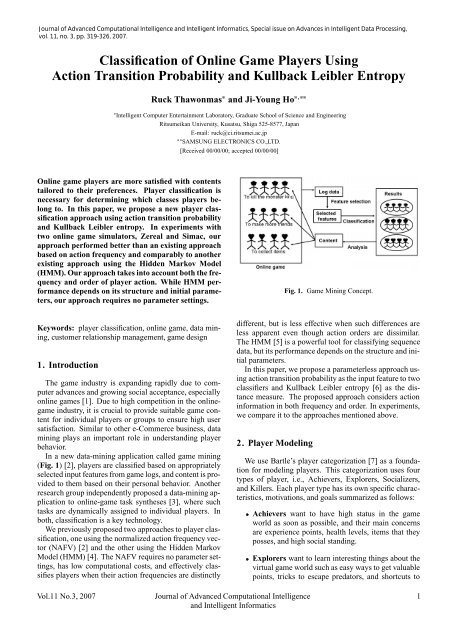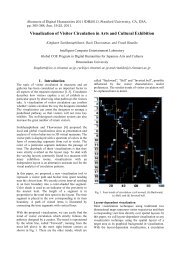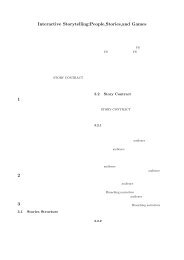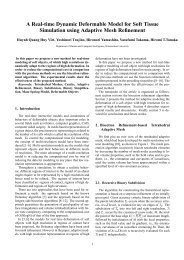Classification of Online Game Players Using Action Transition ...
Classification of Online Game Players Using Action Transition ...
Classification of Online Game Players Using Action Transition ...
- No tags were found...
You also want an ePaper? Increase the reach of your titles
YUMPU automatically turns print PDFs into web optimized ePapers that Google loves.
Thawonmas, R. and Ho, J.Y.World modelsCPU0(master node)VisualizationclientWorld model 1 World model2World model nWorld model3CPU1(world node 1)playersCPU2(world node 2)playersCPU3(world node 1)………CPUn(world node n)Fig. 2. Zereal architecture.PotionKeyPlanAgentFoodDoorKillerMarkovKillerMonsterFig. 3. Zereal’s four game worlds.¯arrive at destinations. They also enjoy demonstratingtheir knowledge to other players.Socializers are interested in relationships and communicationswith other players. They like talkingto each other and trading things in the virtual gameworld.¯ Killers want to kill players and monsters with thetools provided by the game, gaining satisfaction fromtheir high fighting skills and the pain they inflict onothers.Below we describe the simulators, used in our experiments,for generating game logs on players <strong>of</strong> differenttypes. A training data set consists <strong>of</strong> these logs andplayer labels. For simulation data, player types in trainingdata are player models in the corresponding simulator. Inactual games, information from player questionnaires orfrom <strong>Game</strong> Masters is used to label the type <strong>of</strong> player ina given training dataset.2.1. Zereal SimulatorZereal [8] is a multiagent simulation system that simulatesa massively multiplayer online game.Zereal consists <strong>of</strong> a visualization client, a single masternode, and multiple world nodes (sub-nodes) (Fig. 2).Each world node controls its own world environment simultaneously.The master node gathers individual statusinformation from world nodes, and forwards it to the visualizationclient. The visualization client receives thisinformation and produces log files in different formats,including those for analysis and display (Fig. 3).Figure 4 shows typical game logs. The first, second,and third columns therein are the simulation-time step,the current world node, and the actual clock time, respectively.The fourth column shows the agent identifier number,the fifth agent action, the sixth and seventh coordinatesin the game world before and after the action. Thelast column is the agent type. <strong>Action</strong>s and agent typesare extracted from game logs to form action sequences(Fig. 5), in which each character stands for an action describedbelow.Zereal uses three types <strong>of</strong> player agents, i.e., a Killer,Markov Killer, and Plan Agent. These are implementedhaving different characteristics and intelligencelevels, but nine common actions, i.e., Walk(w), Attack(a),PickFood(f), PickPotion(p), PickKey(k), Talk(t), Leave-World(l), EnterWorld(e), and Removed(r). The Markov2 Journal <strong>of</strong> Advanced Computational Intelligence Vol.11 No.3, 2007and Intelligent Informatics
<strong>Classification</strong> <strong>of</strong> <strong>Online</strong> <strong>Game</strong> <strong>Players</strong> with ATPM and KLE58||1||2003-12-8: 20:6:35||1000321||pickupkey||(137,124)||(137,123)||PlanAgent158||1||2003-12-8: 20:6:35||1000338||walk||(131,131)||(132,130)||PlanAgent158||1||2003-12-8: 20:6:35||1000339||walk||(38,3)||(39,4)||PlanAgent158||1||2003-12-8: 20:6:35||1000341||walk||(57,138)||(58,138)||PlanAgent158||1||2003-12-8: 20:6:35||1000347||walk||(32,124)||(33,125)||PlanAgent158||1||2003-12-8: 20:6:35||1000349||walk||(84,127)||(84,128)||PlanAgent158||1||2003-12-8: 20:6:35||1000351||walk||(53,99)||(54,98)||PlanAgent158||1||2003-12-8: 20:6:35||1000354||walk||(17,136)||(18,135)||PlanAgent158||1||2003-12-8: 20:6:35||1000355||walk||(84,33)||(83,34)||Killer158||1||2003-12-8: 20:6:35||1000356||walk||(76,51)||(76,52)||Killer158||1||2003-12-8: 20:6:35||1000357||walk||(69,38)||(70,37)||Killer158||1||2003-12-8: 20:6:35||1000358||walk||(47,8)||(48,8)||Killer158||1||2003-12-8: 20:6:35||1000359||attack||(135,39)||(135,38)||Killer1•••281||1||2003-12-8: 20:11:6||1000147||walk||(121,29)||(122,30)||MarkovKiller1281||1||2003-12-8: 20:11:6||1000148||walk||(41,23)||(40,22)||MarkovKiller1281||1||2003-12-8: 20:11:6||1000150||walk||(136,132)||(137,133)||MarkovKiller1281||1||2003-12-8: 20:11:6||1000151||walk||(36,52)||(35,51)||MarkovKiller1281||1||2003-12-8: 20:11:6||1000154||walk||(69,33)||(70,32)||MarkovKiller1281||1||2003-12-8: 20:11:6||1000158||walk||(69,21)||(70,22)||Monster281||1||2003-12-8: 20:11:6||1000160||walk||(130,88)||(131,87)||Monster281||1||2003-12-8: 20:11:6||1000170||walk||(54,137)||(53,136)||Monster281||1||2003-12-8: 20:11:6||1000191||attack||(71,93)||(70,92)||Monster281||1||2003-12-8: 20:11:6||1000197||attack||(46,120)||(46,121)||Monster281||1||2003-12-8: 20:11:6||1000204||attack||(16,52)||(15,51)||MonsterStartingTradingFightingTalkingMovingDyingGettingFindingLosingFig. 6. Simac state diagram.Fig. 4. Typical game logs.• • •• • •• • •MarkovKiller||1000059||wwwtwwwwwwttwwwwwttwwttwwtwwwtwwtwffwttwtwwwwpwwMarkovKiller||1000060||twwwawwwaawaaaawawtttwtwwwwwpwwwwwwwwwwwwwwwMarkovKiller||1000061||aaawwaawfwwkwwwwwwwaawwwwawawfwfwwwwwwwwwwwf• • •Killer||1000459|| wwaaaawwwwwwwaaaaaawfawwwwwwwwwwwwwwwffwwwwwaaawwwKiller||1000460|| wwwawkwaaaaaaaaaaaaaaawwwwwwwwwwwwfwwwwwwaaaaaawwwwKiller||1000461||wwaaaaaaaaaaaaaaaawaaaaaaaaawwwwwwwwwwaaaawwwwwawaaaww• • •PlanAgent||1000259||wkwwwwwwlewwwwwaawaaaaawwwwwawaaaaaawwwawwwaaawwPlanAgent||1000260||wwawawwawaawaaaaaaaaawaaaaaawwwaaaaaaawaaaaawkwwwwwPlanAgent||1000261||wwkwwwwkwwwwwfwwwwtawwwwwwwaaaaawaawwwdwwwwwww• • •• • •• • •Fig. 5. Typical action sequences.Killer is implemented by a Markov model consisting <strong>of</strong>eight states, i.e., fight, talk, hunt, transit, go for power up,flee, bored, and transported; only certain actions out <strong>of</strong>the nine can be performed in a given state.2.2. Simac SimulatorWe developed a simulator called Simac for simulatingplayer types and actions not available in Zereal. Basedon a simple Markov model for agent modeling, we developedSimac to generate reliable action sequences withmore agent types and actions using the Python language.The Simac simulator has nine different states to representsituations <strong>of</strong> a player agent in playing, i.e., starting, moving,fighting, getting, losing, finding, talking, trading, anddying, plus 51 actions. Each action is assigned to one <strong>of</strong>the nine states.Through the Markov model (Fig. 6), Simac can simulatemany types <strong>of</strong> players. For reference, the Markovmodel <strong>of</strong> Killer is described in Appendix A. Simac actionsequence formats are the same as those <strong>of</strong> Zereal.3. Methodologies3.1. <strong>Action</strong> <strong>Transition</strong> Probability Matrix (ATPM)The action transition probability matrix (ATPM) derivedfrom action sequences takes into account action ordersthrough action transition probabilities. It also holdsaction frequency information through its rows because thesummation <strong>of</strong> each row is the action frequency <strong>of</strong> the correspondingaction. The detailed procedure is shown asfollows:¯¯Step 1: Initialize m¢m action transition frequencymatrix F by setting all elements to 1 where m is thenumber <strong>of</strong> actions. Thereby, only non-zero elementsexist in the calculation <strong>of</strong> Kullback Leibler entropydescribed in the next subsection.Step 2: From left to right, scan subsequences <strong>of</strong>length two s k s k·1 in each action sequence s s 1 s 2 s l , where l is the sequence length, and incrementthe element <strong>of</strong> matrix F that matches thetransition <strong>of</strong> the current subsequence as follows:F qr F qr · 1 . . . . . . . . . . . (1)where q and r are the indices <strong>of</strong> actions s k and s k·1 ,respectively, and k (1 k l 1) is the current scanningposition.Step 3 : Calculate the ATPM by dividing each element<strong>of</strong> F with the summation <strong>of</strong> all elements asfollows:F ijATPM ij ∑ m i1 ∑ m j1 F . . . . . . (2)ij3.2. Kullback Leibler Entropy (KLE)Kullback Leibler entropy (KLE) [6] is one <strong>of</strong> the mostwidely used distance measures for comparing similaritybetween two probability distributions. Because KLEis asymmetric, we symmetrize it by defining distanceD´M a M b µD´M b M a µ as the average <strong>of</strong> two entropiesVol.11 No.3, 2007 Journal <strong>of</strong> Advanced Computational Intelligence 3and Intelligent Informatics
<strong>Classification</strong> <strong>of</strong> <strong>Online</strong> <strong>Game</strong> <strong>Players</strong> with ATPM and KLE100.00%Identification Performance90.00%80.00%70.00%60.00%50.00%ATPM AMBRATPM PrototypeNAFV AMBRNAFV PrototypeHMM40.00%1 2 3 4 5 6 7 8 9 10TrialsFig. 7. Performance comparison for Zereal logs with three agent types.90.00%Identification performance80.00%70.00%ATPM AMBRATPM PrototypeNAFV AMBRNAFV PrototypeHMM60.00%1 2 3 4 5 6 7 8 9 10TrialsFig. 8. Performance comparison for Zereal logs with two agent types.¯The EMK prioritizes some actions over others in agiven situation, and state transition probabilities inthe Markov matrix differ. This type represents veteranplayers with favored playing styles.In the performances <strong>of</strong> the five classification approaches(Fig. 8), AMBR and Prototype using the NAFV,as their input features, are least effective, as expected. TheHMM, which considers action orders, shows the best performance,followed by the ATPM Prototype and ATPMAMBR.Although the HMM has the highest performance, itdoes not necessarily mean that the HMM is more pragmaticthan the ATPM. This is because the HMM structureand initial parameters were set using a priori. It iscommonly known that the HMM performance dependson its structure and initial parameters. To verify this, wetrained the HMM with all parameters randomly initialized.The average performance for ten trials <strong>of</strong> the HMMwith four, six, and eight states was 74.6% (standard deviation= 24.5), 82.1% (standard deviation = 27.5), and78.2% (standard deviation = 27.8), respectively. In contrast,the ATPM Prototype and ATPM AMBR require noparameter settings.4.3. Simac Data with Four Types <strong>of</strong> AgentEach dataset was obtained by running 2000 agents for500 simulation-time cycles. Four types <strong>of</strong> agent based onBartle’s categorization, i.e., Achievers, Explorers, Socializers,and Killers, were simulated (Fig. 9).The ATPM Prototype has the best performance, followedby the HMM. For the same input features, thePrototype is superior to AMBR. Because the four playertypes implemented in Simac have distinct characteristics,prototype-based classifiers such as Prototype and theHMM are more appropriate than AMBR.4.4. Simac Data with Two Types <strong>of</strong> AgentIn this experiment, two types <strong>of</strong> agents were implementedto obtain data in which each agent type has similaraction frequencies but different action orders. OtherVol.11 No.3, 2007 Journal <strong>of</strong> Advanced Computational Intelligence 5and Intelligent Informatics
Thawonmas, R. and Ho, J.Y.100.00%Identification Performance90.00%80.00%ATPM AMBRATPM PrototypeNAFV AMBRNAFV PrototypeHMM70.00%1 2 3 4 5 6 7 8 9 10TrialsFig. 9. Performance comparison for Simac logs with four agent types.100.00%Identification Performance90.00%80.00%70.00%60.00%ATPM AMBRATPM PrototypeNAFV AMBRNAFV PrototypeHMM50.00%1 2 3 4 5 6 7 8 9 10TrialsFig. 10. Performance comparison for Simac logs with two agent types.experiment settings were same as those in the previoussubsection.Agent types are summarized as follows:¯¯The Killer prioritizes killing, roaming around lookingfor monsters or players to attack. The differencebetween the Killer and the Strong Killer below is thatthe Killer requires more attacks to kill a monster becauseit is weaker than the Strong Killer.The Strong Killer, similar to the Killer, attacks anythingalive. It kills monsters with fewer attacks thanthe Killer.Killers and Strong Killers have typical action patternswith the same action frequencies but action orders are differentreflecting their strength. A typical action sequence<strong>of</strong> the Killer is “wwwwaaaawwwwaaaaww” while that<strong>of</strong> the Strong Killer is “wwaawwaawwaawwaaww”, with“w” and “a” standing for walk and attack, respectively.The HMM has the best performance, followed by theATPM Prototype with a shade <strong>of</strong> difference (Fig. 10).As explained earlier, the HMM’s high performance is notsurprising because knowledge in the simulator was used.The performances <strong>of</strong> both Prototype and AMBR using theNAFV as their input features are the lowest because theNAFV cannot handle action orders in data. Prototype performsbetter than AMBR.5. ConclusionsWe have proposed a new player classification approach(ATPM AMBR and ATPM Prototype) using the ATPM asthe input feature to the two classifiers in use and KLE asthe distance measure. The experimental results show thatour approach has stable performance for player logs generatedby Zereal and Simac. The ATPM Prototype performsbetter than the ATPM AMBR in identifying playertypes with distinct characteristics.The existing approach using the NAFV (NAFV AMBRand NAFV Prototype) shows low performance exceptwhen player types have distinctly different action frequen-6 Journal <strong>of</strong> Advanced Computational Intelligence Vol.11 No.3, 2007and Intelligent Informatics
<strong>Classification</strong> <strong>of</strong> <strong>Online</strong> <strong>Game</strong> <strong>Players</strong> with ATPM and KLETable 1. State transition probability matrix <strong>of</strong> Killers (Unit:%).States Moving Fighting Getting Losing Talking Trading Finding DyingMoving 40 19.99 10 10 10 0 10 0.01Fighting 20 29.98 25 25 0 0 0 0.02Getting 99.9 0 0 0 0 0 0 0.01Losing 49.99 49.99 0 0 0 0 0 0.02Talking 20 0 0 0 69.99 10 0 0.01Trading 30 0 0 0 69.99 0 0 0.01Finding 40 0 40 19.99 0 0 0 0.01Dying 0 0 0 0 0 0 0 0cies. In all cases, the HMM, with the use <strong>of</strong> a prior, showscomparatively high performance, especially for data withspecific patterns <strong>of</strong> action orders. The HMM performancedepends, however, on initial settings.The proposed approach requires no parameter settingsand is promising for online-game player classification. Asour future work, we will conduct experiments with actualonline game data and user behavior data in ubiquitous environments.AcknowledgementsWork by the first author was supported in part by the RitsumeikanUniversity’s Kyoto Art and Entertainment Innovation Research, aproject <strong>of</strong> the 21 st Century Center <strong>of</strong> Excellence Program fundedby the Japanese Ministry <strong>of</strong> Education, Culture, Sports, Scienceand Technology (MEXT) and by Grant-in-Aid for Scientific Research(C), No. 16500091, the Japan Society for Promotion <strong>of</strong>Science. The second author was supported in part by a MEXTscholarship. We thank the reviewers for their invaluable comments.[9] J. Y. Ho and R. Thawonmas, “Episode Detection with VectorSpace Model in Agent Behavior Sequences <strong>of</strong> MMOGs,” Proc. FutureBusiness Technology Conference 2004 (FUBUTEC’2004), IN-SEAD, Fontainebleau, France, pp. 47-54, Mar., 2004.[10] J. A. B. Michael and G. Lin<strong>of</strong>f, “Data Mining Techniques: For Marketing,Sales, and Customer Support,” John Wiley & Sons, Inc.,N.Y., 1997.[11] http://www.ice.ci.ritsumei.ac.jp/˜ruck/downloads.htmlAppendix A. Markov Model <strong>of</strong> Simac KillerHere, due to space limit, we only show the state transitionprobability matrix, the observation probability matrix,and the initial state distribution matrix <strong>of</strong> the SimacKiller in Tables 1, 2, and 3, respectively. The transitionprobability matrix <strong>of</strong> each agent type differs reflecting itsspecific characteristics. All agent types, however, havethe same observation probability matrix and initial statedistribution matrix.References:[1] K. Alexander, R. Batle, E. Castronova, G. Costikyan, J. Hayter,T. Kurz, D. Manachi, and J. Smith, The Themis Report 2004 – Preview,2004.[2] R. Thawonmas, J. Y. Ho, and Y. Matsumoto, “User Type Identificationin Virtual Worlds,” Agent-Based Modeling Meets Gaming Simulation(Post-Proceedings <strong>of</strong> the Session Conference <strong>of</strong> the ISAGA,International Simulation and Gaming Association, 2003), Series:Springer Series on Agent Based Social Systems, Vol.2, K. Arai,H. Deguchi, and H. Matsui (Eds.), Springer, pp. 79-88, March,2006.[3] L. Shi and W. Huang, “Apply Social Network Analysis and DataMining to Dynamic Task Synthesis for Persistent MMORPG VirtualWorld,” Lecture Notes in Computer Science, M. Rauterberg(Ed.), Vol.3166 (Proc. ICEC 2004), pp. 204-215, Sep., 2004.[4] Y. Matsumoto and R. Thawonmas, “MMOG Player <strong>Classification</strong><strong>Using</strong> Hidden Markov Models,” Lecture Notes in Computer Science,M. Rauterberg (Ed.), Vol.3166 (Proc. ICEC 2004), pp. 429-434, Sep., 2004.[5] L. R. Rabiner, “A Tutorial on Hidden Markov Models and SelectedApplications in Speech Recognition,” Proc. IEEE, Vol.77(2),pp. 257-285, Feb., 1989.[6] G. Deco and D. Obradovic, “An Information-Theoretic Approachto Neural Computing,” Springer, Berlin, Germany, 1996.[7] R. Bartle, “Hearts, Clubs, Diamonds, Spades: <strong>Players</strong> Who SuitMUDs,” The Journal <strong>of</strong> Virtual Environments, 1(1), 1996,[8] A. Tveit, Y. Rein, V. I. Jorgen, and M. Matskin, “Scalable Agent-Based Simulation <strong>of</strong> <strong>Players</strong> in Massively Multiplayer <strong>Online</strong><strong>Game</strong>s,” Proc. the 8th Scandinavian Conference on Artificial Intelligence(SCAI2003), Bergen, Norway, Nov., 2003.Vol.11 No.3, 2007 Journal <strong>of</strong> Advanced Computational Intelligence 7and Intelligent Informatics
Thawonmas, R. and Ho, J.Y.Table 2. Observation probability matrix for all agent types.State <strong>Action</strong>Moving Walk (70%), Run (20%), Jump (10%)Fighting Use magic 1 (10%), 2 (10%), 3 (5%), Use weapon 1 (10%), 2 (10%), 3 (5%), Hitwith hands strong (10%), middle (10%), weak (5%), Hit with legs strong (10%),middle (10%), weak (5%)Getting Get item 1 (10%), 2 (10%), 3 (10%), Get weapon 1 (10%), 2 (10%), 3 (10%), Getmagic 1 (10%), 2 (10%), 3 (10%), Get power points (5%),Get life points (5%)Losing Lose item 1 (10%), 2 (10%), 3 (10%), Lose weapon 1 (10%), 2 (10%), 3 (10%),Lose magic 1 (10%), 2 (10%), 3 (10%), Lose power points (5%), Lose life points(5%)Finding Find secrete place 1 (20%), 2 (15%), 3 (15%), Find secrete item 1 (20%), 2 (15%),3 (15%)Talking Talk (100%)Trading Sell item 1 (20%), 2 (15%), 3 (15%), Buy item 1 (20%), 2 (15%), 3 (15%)Dying Die (100%)Table 3. Initial state distribution matrix for all agent types (Unit:%).States Moving Fighting Getting Losing Talking Trading Finding DyingProbability 99.95 0.01 0.01 0.01 0.01 0 0.01 0Name:Ruck ThawonmasAffiliation:Intelligent Computer Entertainment Laboratory,Department <strong>of</strong> Human and Computer Intelligence,Ritsumeikan UniversityName:Ji-Young HoAffiliation:Mobile R&D Group 1 (S/W Lab), Mobile CommunicationDivision, Telecommunication NetworkBusiness, SAMSUNG ELECTRONICSCO.,LTD, KoreaAddress:1-1-1 Nojihigashi, Kusatsu, Shiga 525-8577, JapanBrief Biographical History:2002.4 Joined Ritsumeikan University as associate pr<strong>of</strong>essor2004.4 Promoted to full pr<strong>of</strong>essorMain Works:¯ R. Thawonmas and S. Abe, “A Novel Approach to Feature SelectionBased on Analysis <strong>of</strong> Class Regions,” IEEE Trans. Systems, Man, andCybernetics, Vol.27, Part B, No.2, pp. 196-207, 1997.¯ R. Thawonmas, A. Cichocki, and S. Amari, “A Cascade Neural Networkfor Blind Signal Extraction without Spurious Equilibria,” IEICE Trans. onFundamentals <strong>of</strong> Electronics, Communications and Computer Sciences,Vol.E81-A, No.9, pp. 1833-1846, 1998.Membership in Learned Societies:¯ IEEE Senior Member¯ Association for Computing Machinery (ACM)¯ The Institute <strong>of</strong> Electronics, Information and Communication Engineers(IEICE)¯ Information Processing Society <strong>of</strong> Japan (IPSJ)¯ International <strong>Game</strong> Developers Association (IGDA)Brief Biographical History:2002.10-2004.9 Master’s student at the Graduate School <strong>of</strong> Science andEngineering, Ritsumeikan UniversityMain Works:¯ J.-Y. Ho and R. Thawonmas, “Episode Detection with Vector SpaceModel in Agent Behavior Sequences <strong>of</strong> MMOGs,” Proc. <strong>of</strong> FutureBusiness Technology Conference 2004 (FUBUTEC’2004), INSEAD,Fontainebleau, France, pp. 47-54, Mar., 2004.8 Journal <strong>of</strong> Advanced Computational Intelligence Vol.11 No.3, 2007and Intelligent Informatics







